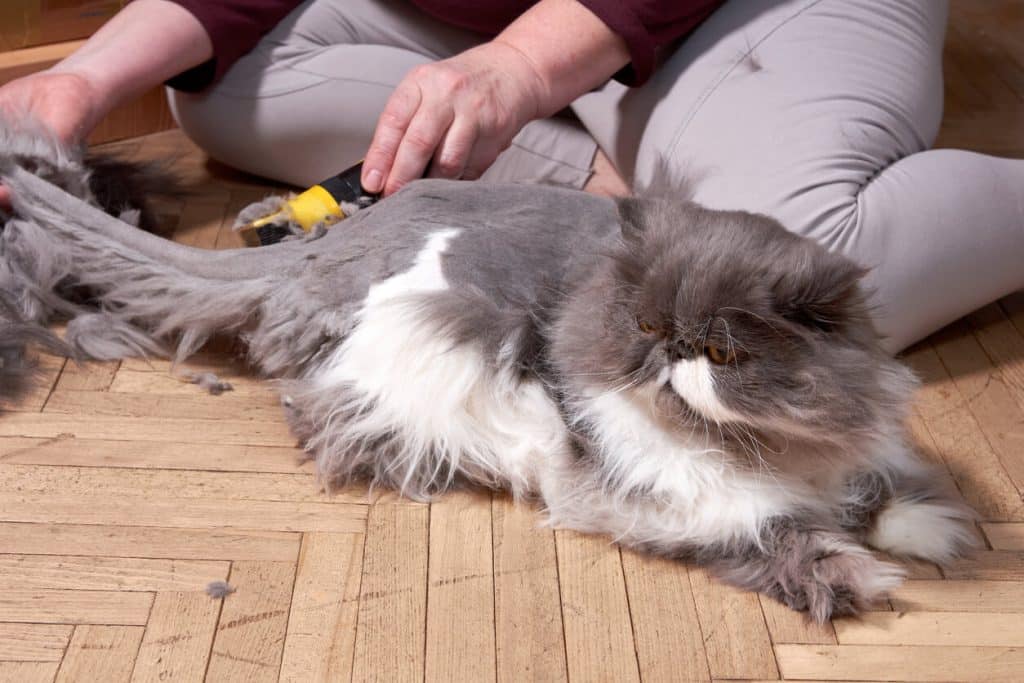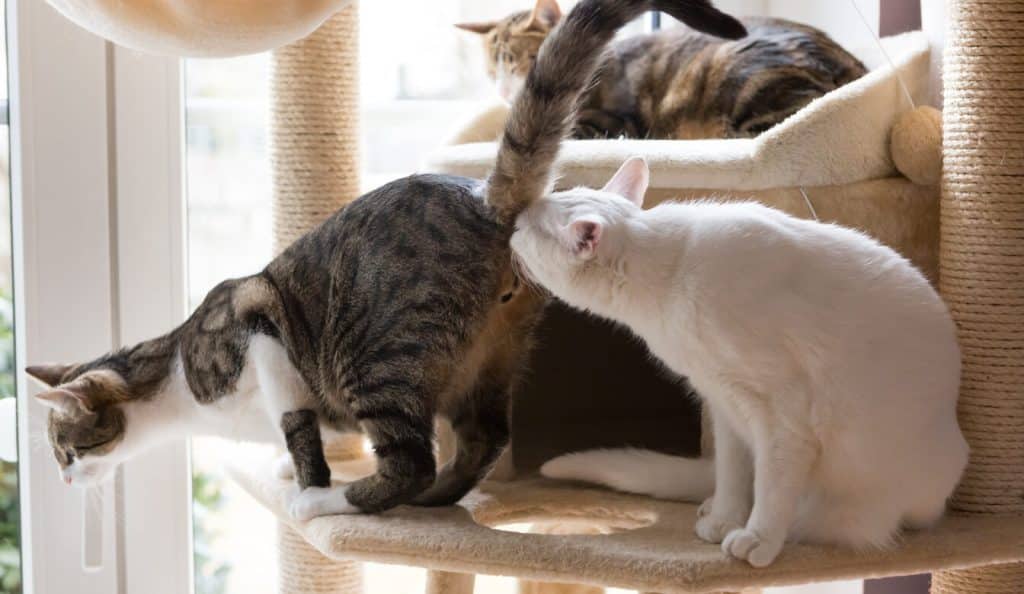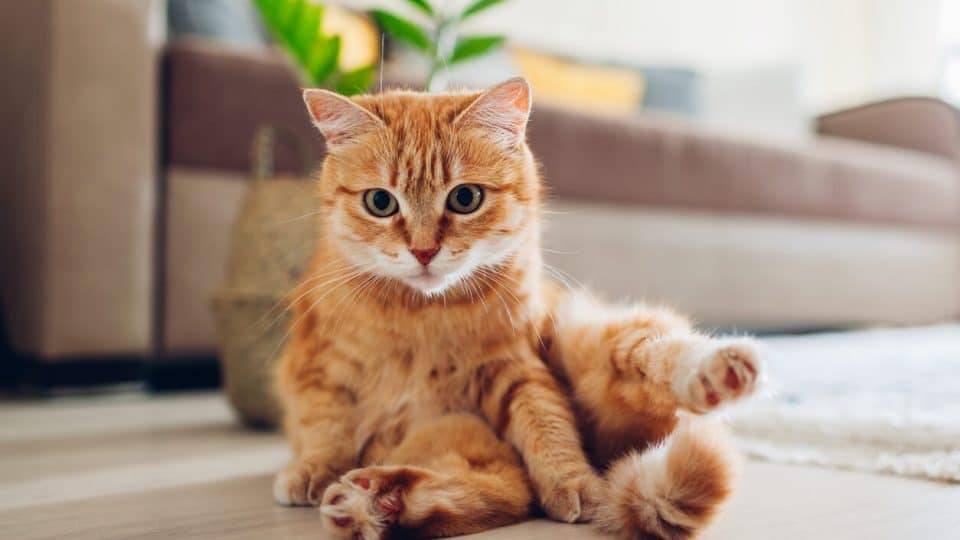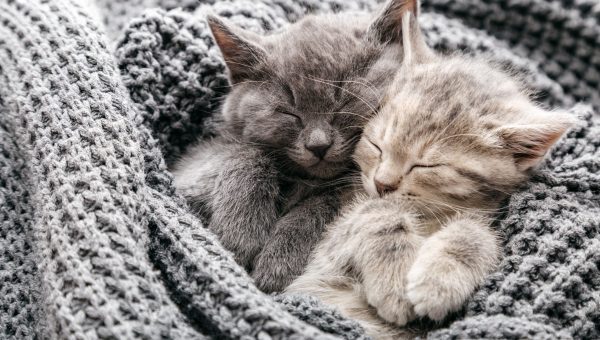Cats engaging in random behaviors is nothing new. Sitting in strange places, meowing to themselves, purposefully knocking things off shelves… these are all normal cat behaviors. But now you’ve noticed your cat dragging their butt across the floor — and they don’t look happy about it.
Good news: The answer is often simple. The occasional butt scratch against a post, table leg, or carpet is your cat’s attempt to soothe an itch or remove stuck poop. A quick check can help you — and your cat — see if anything is stuck.
“Scooting in cats is quite common,” confirms Dr. Patrik Holmboe, Head Veterinarian for Cooper Pet Care. You may notice additional behaviors like licking or chewing and scratching. The main reason your cat is scooting is because your cat is experiencing “irritation or itching around the anal area,” Holmboe explains.
You’ll want to see a vet, however, if and when your cat’s scooting becomes chronic. Sometimes scooting in-itself can be a cause of more scooting. When a cat drags their butt along the floor for extended periods and on a regular basis, this can trigger more irritation — or it may indicate a more serious cause and a need for medical treatment.
Need to know if your cat’s butt scooting is worth going to the vet for? Let’s take a look at the potential causes, treatments, and how to prevent future skid marks around your home.
Your Cat’s Butt Has Stuck Poop
Know how frustrating it is when something is stuck to your shoe? Cats feel the same annoyance when something is attached to their fur.
If you catch your cat dragging their butt, Holmboe recommends first checking if there is stuck poop. Poop is one of the most common things that gets stuck around the anus. And since cats can’t reach their butts with their paws or mouth, they have to resort to another measure to try and get it off: scooting.
For owners of cats with long hair, this is something to check for regularly. “Pay particular attention to the area around the anus and the vulva (for females),” shares Dr. Kelly Diehl, Veterinarian and Senior Director of Science and Communication at Morris Animal Foundation.
Preventing stuck poop
Making sure your cat has enough fiber in their diet can help with any issues of cat constipation or diarrhea. You’ll also want to regularly check and clear away any stuck poop. Dried poop and matted fur can cause further skin issues. If your cat freaks out when you try to look at their butt, try to use treats as a distraction — or enlist some help from friends in keeping your cat calm.
“If the feces gets matted into the fur and stuck to the skin for too long, it can lead to skin irritation and even infection,” Holmboe reveals. A good cat conditioner may also help with soothing your cat’s skin and getting fur untangled.

iStock/Akifyeva Svetlana
For fur that is so matted you can’t untangle it, Holmboe recommends taking your cat to a groomer for a full bath experience. The groomer may shave any matted fur, but they can also let you know how the scooting affected your cat’s skin. Depending on the severity, you may also go to the vet for medication to treat irritated skin.
Note: If the poop is attached to a string, do not pull on the string. Take your cat to the vet to get the string properly removed as pulling on it may damage their intestines.
Your Cat’s Anal Glands Are Full
“The anal glands are two small sacs of fluid which sit just inside the rectum,” explains Holmboe. “Their purpose is to excrete a foul-smelling liquid onto the feces, which is thought to help with territory marking.” The smell may even be noticeable to you and other cats.
Anal glands might be small, but they can have a big impact on your cat’s behavior. When anal glands are full, impacted, or infected, this can lead to soreness and irritation in cats. Smaller cat breeds are more likely to have anal sac issues than larger cat breeds.
Ask your vet to express your cat’s anal glands
Fortunately, the solution is relatively straightforward. For full and impacted glands, “a quick trip to the vet to have them emptied is often the best solution,” Holmboe reveals. Your vet can let you know if anal gland expression is a regular hygiene need for your cat. Some groomers offer anal gland expression as part of a grooming package.
In the case of severe anal sac disease, additional treatments are necessary. Your vet may prescribe antibiotics and anti-inflammatory medications, either orally or through infusion.

iStock/w-ings
Your Cat Has an Infection or Inflammation
Allergies, skin inflammation, and infections can cause a cat to pay extra attention to their butt. When you take a closer look, you might also see signs of:
- bald patches of fur, from scooting, licking, or chewing
- redness
- swelling
- flaky or scaly skin
- bumps
These symptoms could all be a result of fleas, mites, acne, or skin problems. “The most common skin conditions are due to moisture trapped in the area, especially in cases of long hair,” Diehl reveals. “If a cat scoots a lot for other reasons, they can develop a skin infection.”
Holmboe states that pollen, dust, food, and grasses often trigger allergies in cats. While “common areas to be affected are the face, ears, armpits, groin,” he continues, the anal region is also susceptible — and “scooting is a way for the cat to itch the skin around the anus and rump.”
Internal inflammation affecting your cat’s vagina, bladder, or intestines may cause scooting or licking of the lower body. “A random skin infection, urinary tract infection, or vaginal fold infection could also lead to the same [scooting] issue,” confirms Holmboe.
See a vet to confirm the root cause of scooting
Skin infections aren’t always noticeable, but your vet can determine the cause by asking you a series of questions about your cat’s routine behavior and examining their skin. You won’t be able to clear up your cat’s infection or tackle an allergy on your own. To ensure the problem is entirely resolved, Diehl explains that both the infection and root cause will need to be treated.
Holmboe emphasizes on making an appointment with a vet, especially as the exact cause can often be tricky to pin down. Sometimes there can be overlapping skin issues to address.
For example, “flea allergies are controlled with proper flea control, [while] a general skin condition called Feline Atopic Dermatitis is generally controlled with an anti-itch medication called cyclosporine,” Holmboe reveals.
Your Cat Has Worms
While worms aren’t the biggest factor behind cat scooting, reveals Diehl, they can play a role. The itching and irritation these critters cause can lead your cat to drag their butt along the floor as they try to ease the sensations.
Tapeworms and roundworms are two commonly seen parasitic worms in cats. “As part of their lifecycle, they will exit as live worms from the anus,” says Holmboe. Depending on the type of worm, Holmboe notes that you’ll see what looks like grains of rice or spaghetti in your cat’s poop.
Bring a fresh fecal sample to the vet. You should be able to drop off a sample anytime, even if you have to wait a few days later for the actual appointment. Testing the sample helps your vet figure out which parasite your cat has, says Diehl. From there, your vet can determine what treatment is best.
“There are lots of different dewormers on the market, and the type used depends on the type of parasite,” Diehl notes.
How can I prevent my cat from getting worms?
Worm prevention is especially difficult for outdoor cats, however, Diehl notes that the following approaches can help:
- Do a yearly fecal sample on all cats in the household
- Make sure any new cat has been dewormed before you take them home
- Stay up to date with flea control. A cat can accidentally ingest an infected flea during grooming and get infected with tapeworms
Your Cat Has A Lump or Cyst
New lump growths and cysts on cats can be cancerous or non-cancerous — so don’t necessarily assume the worst. Cysts, for example, can be a result of blocked hair follicles while tiny bumps can be a result of acne. Scooting is a way for the cat to try and ease irritation caused by a lump or cyst.
Fortunately, “it’s very rare for cats to develop growths in this area,” Diehl states, highlighting how growths around the butt are more common in dogs.
However, if you notice a new lump or growth anywhere on your cat’s body — butt or otherwise — “it’s important to get them into the veterinarian right away,” asserts Diehl. Only a vet can determine whether the lump requires action.
Takeaway: Stay On Top of Your Cat’s Health
Various factors — from stuck poop to allergies — can cause your cat to drag their butt along the floor. If you notice your cat repeatedly and regularly scooting along the floor, pay a visit to the vet to determine the cause and discuss treatments. Remedies may include antibiotics, flea treatments, and anti-inflammatories to help ease irritation and swelling.
If poop and fleas are an issue, your vet may also recommend maintaining your cat’s overall health with:
- An increase in fiber intake, with supplements. You can also try adding pumpkin to their food
- A diet for sensitive stomachs to help identify the cause of skin allergies
- Regular grooming sessions, especially if your cat is overweight and cannot reach certain areas
- Monthly flea preventatives, to lower the risk of skin irritation and worms
Cats clean themselves regularly by nature (spending up to 50% of their day grooming!), but sometimes, they need a helping hand. Ensuring your cat’s butt region stays tidy and clean can also help prevent poop getting stuck, and makes checking in on their rear end skin an easier process for you and your cat. See if these cat grooming tools are the answer to making your cat’s life scoot-free.
But also be mindful of how long you are investigating or touching your cat. Too much attention and touching can cause overstimulation aggression. If your cat gives a clear signal, like a nip, to stop, take a breather and try again in a few minutes.





